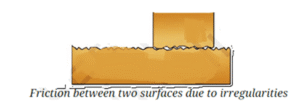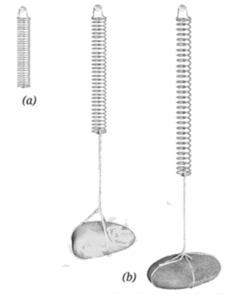Exploring Forces
NCERT-Class-8-Science (Curiosity)-Chapter-5
Notes
What Is a Force? :
Forces are the fundamental interactions that govern all motion and change in the universe.
In science, a force is defined as a push or a pull resulting from an interaction between two objects. A force cannot exist without such interaction.
What Can a Force Do to the Bodies on Which It Is Applied? :
The application of a force can have several distinct effects on an object. It can:
- Making an object move from rest: e.g. When you kick a stationary football, the force from your foot sets the ball in motion.
- Changing the speed of a moving object: e.g. If a friend holds your moving bicycle from behind, the pulling force they apply decreases its speed.
- Changing the direction of motion of an object: e.g. Hitting a moving ball with a bat applies a force that changes the ball's direction.
- Bringing about a change in the shape of an object: Forces can deform objects, e.g. when you press an inflated balloon, stretch a rubber band, or roll out a chapati.
- Causing some or all of these effects simultaneously.
Are Forces an Interaction Between Two or More Objects? :
Interaction Is Key : Forces always arise from the interaction between two or more objects. One object cannot exert a force in isolation.
Examples :
- Pushing a box involves the interaction between your hand and the box.
- Earth’s gravitational pull on you is due to the interaction between your body and the Earth.
SI unit : The standard international (SI) unit used to measure force is the newton (N). 1 N = 105 Dyne
What Are the Different Types of Forces? :
Forces are broadly classified into two categories:
- (i) Contact forces, which require direct physical touch (e.g., friction, muscular force).
- (ii) Non-contact forces, which act without physical contact and can operate across empty space (e.g., gravitational, magnetic, and electrostatic forces).
Contact Forces:
Contact forces require physical touch between objects, either directly or through a medium like a rope or stick. They are part of daily life experiences such as lifting, pushing, or walking.
(i) Muscular Force :
Muscular force is the force created by muscles in living beings. It is a contact force, meaning it works only when something touches or pushes.
- In Humans: Helps us walk, run, lift things, and push or pull objects like doors.
- In Animals: Used for movement and survival, like running, hunting, or escaping danger.
- Inside the Body: Helps in chewing food and moving it through the digestive system. The heart muscles use muscular force to pump blood all over the body.
(ii) Frictional Force:
Friction is a contact force that acts when an object moves or tries to move over another surface. It resists motion and is present everywhere.
Key Characteristics of Friction :
Opposes Motion : Friction always acts in the opposite direction of movement or attempted movement. Example: A rolling ball slows down and stops due to friction.
Caused by Surface Irregularities : Even smooth surfaces have tiny bumps and valleys. These microscopic irregularities interlock, resisting movement.
Depends on Surface Type :
- Rough surfaces → more friction.
- Smooth surfaces → less friction.
Example: A bicycle stops faster on a rough road than on a smooth one.
Friction in Fluids :
- Friction also occurs in liquids and gases.
- Examples: Air resistance (while cycling), water resistance (while swimming).
Friction is a contact force, but some forces like gravity, magnetism, and electrostatic force can act without touching, even across space.
Non-Contact Forces:
Non-contact forces are forces that act without touching the object. They work from a distance and are called “action-at-a-distance” forces.
(i) Magnetic Force :
- A magnet can attract or repel another magnet or magnetic material without touching.
- Unlike poles (North–South) → attract.
- Like poles (North–North or South–South) → repel.
(ii) Electrostatic Force :
- A charged object can push or pull another object without contact.
- Example: Rub two balloons with a woollen cloth → they get similar charges and repel each other.
- Bring the cloth near a balloon → it attracts the balloon (opposite charges).
- Like charges → repel
- Unlike charges → attract
(iii) Gravitational Force :
- The Earth pulls everything towards itself. This pull is called gravity.
- It is always attractive, unlike magnetic or electrostatic forces.
- Example: A ball thrown up slows down, stops, then falls back faster due to gravity.
Weight and Its Measurement :
In science, mass and weight are not the same, even though people often mix them up in daily life.
Comparison Table :
| Feature | Mass | Weight |
| Definition | Amount of matter in an object | Gravitational force pulling the object |
| Constancy | Same everywhere (Earth, Moon, etc.) | Changes with location (depends on gravity) |
| SI Unit | Kilogram (kg) or gram (g) | Newton (N) |
| Measured By | Beam balance | Spring balance |
Common Mistake : Saying “the weight of the wheat bag is 10 kg” is scientifically wrong. It should be: “the mass of the wheat bag is 10 kg.”
Weight on Different Planets (for 1 kg mass) :
| Celestial Body | Weight |
| Earth | 10 N |
| Moon | 1.6 N |
| Mars | 3.8 N |
| Venus | 9 N |
| Jupiter | 25.4 N |
How Spring Balance Works :
- A spring balance stretches when an object is hung.
- The stretch is proportional to the gravitational pull (weight).
Floating and Sinking :
Forces don’t just act on solids—they also work in liquids and gases. One important force in fluids is buoyancy.
What is Buoyant Force? : When an object is placed in water, it feels an upward force called buoyant force or upthrust, which opposes gravity.
- When you dip a mug in water, it feels lighter.
- That’s because water pushes upward on the mug.
- This upward force is called buoyant force or upthrust.
Floating vs Sinking :
The weight of the object (downward force) and the buoyant force (upward force) decide what happens:
| Condition | Result |
| Weight > Buoyant Force | Object sinks |
| Weight = Buoyant Force | Object floats |
Real-Life Example :
- A stone sinks in water → heavy, less buoyant force.
- A plastic ball floats → light, buoyant force balances weight.
Glossary of Key Terms :
| Term | Definition |
| Archimedes' Principle | The principle stating that when an object is fully or partially immersed in a liquid, it experiences an upward force equal to the weight of the liquid it displaces. |
| Buoyant Force (Upthrust) | The upward force applied by a liquid on an object that is placed in it. |
| Charged Object | An object that has acquired static electrical charges, for instance, by being rubbed against another object of a certain material. |
| Contact Forces | Forces that act only when there is physical contact between the interacting objects. |
| Electrostatic Force | The force exerted by a charged body on another charged or uncharged body. It is a non-contact force. |
| Force | A push or pull on an object resulting from the object’s interaction with another object. |
| Force of Gravity (Gravity) | The gravitational force exerted by the Earth on objects, pulling them towards its center. |
| Friction (Force of Friction) | The contact force that comes into play when an object moves or tries to move over another surface, always acting in a direction opposite to the motion. |
| Gravitational Force | The force with which the Earth attracts objects towards itself. It is a non-contact, always attractive force. |
| Magnetic Force | The force exerted by a magnet on another magnet or on a magnetic material. It is a non-contact force. |
| Mass | The amount of matter in an object, measured in grams (g) or kilograms (kg). Its value remains the same at every place. |
| Muscular Force | A type of contact force caused by the action of muscles in the body contracting and elongating. |
| Newton (N) | The SI (Standard International) unit of force and weight. |
| Non-contact Forces | Forces whose effect can be experienced even if the interacting objects are not in physical contact. |
| Spring Balance | A device used to measure weight (force), consisting of a spring that stretches in proportion to the force applied. |
| Static Charges | Electrical charges that build up on the surfaces of certain objects when rubbed together and do not move by themselves. |
| Weight | The force with which the Earth pulls an object towards itself. It is measured in newtons (N) and can vary from place to place. |
Key Features of Kitabcd Exam Master :
|
Click on below links to get PDF from store
PDF : Curiosity-Chapter-5-Exploring Forces– Notes
PDF : Curiosity-Chapter-5-Exploring Forces– Exam Master
Main Page : NCERT-Class-8-Science (Curiosity) – All chapters notes, solutions, videos, test, pdf.
Previous Chapter : Chapter-3- Health: The Ultimate Treasure – Online Notes
Next Chapter : Chapter-5- Exploring Forces – Online Notes



We reply to valid query.